Clamping Circuits
Certain applications in electronics require that the upper or lower extremity of a wave be fixed at a specific value In such applications ,a clamping/clamper circuits are used.
A circuit that places either the positive or negative peak of a signal at a desired D.C level is known as a clamping circuit. A clamping circuit introduces (or restores) a D.C level to an A.C signal. Thus a clamping circuit is also known as D.C restorer, or D.C reinserted or a baseline stabilizer. The following are two general types of clamping.
- Positive clamping occurs when negative peaks raised or clamped to ground or on the zero level In other words, it pushes the signal upwards so that negative peaks fall on the zero level.
- Negative clamping occurs when positive peaks raised or clamped to ground or on the zero level In other words, it pushes the signal downwards so that the positive peaks fall on the zero level.
In both cases the shape of the original signal has not changed, only there is vertical shift in the signal Fig. 1 shows the clamping wave form.
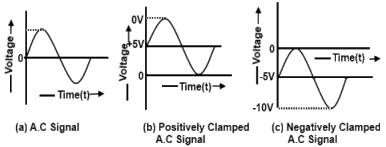
Diode Clampers
POSITIVE CLAMPER
Fig 2 shows the circuit of a positive clamper It consists of a diode and a capacitor the clamper output is taken across the load resistance R.

During the negative half cycle of the input voltage, the diode conducts heavily and behaves as a closed switch At the negative peak, the capacitor is charged to maximum voltage V slightly beyond the negative peak, the diode is shunt off and the capacitor charged to Vm behaves as a battery during the positive half cycle of the input signal. The diode is reversed biased and the output voltage will be equal to Vm + V this gives positive clamped voltage and is called positive clamper circuit.
Positive clamper with bias
Biased clamper circuit operates in exactly the same manner as unbiased clampers. The different is only that a dc bias voltage is add in series with the diode and resistor. A biased clamper means that the clamping can be done at any voltage level other than zero.
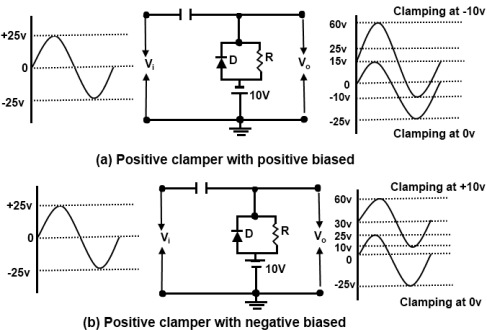
Fig 3(a) shows the circuit of positive clamper with positive biased Here a battery of 10 V is added in such a way that the clamping take place positively at 10V. Similarly, it is possible to clamp the input wave form positively at -10V by reversing the battery connections as shown in Fig 3(b).
NEGATIVE CLAMPER
Fig 4 shows the circuit of a negative clamper during the positive half cycle of the input signal, the capacitor is charged to Vm, with the polarity shown in Fig 4. Observe that voltage across the capacitor is opposing the input voltage V. This gives negative clamped voltage and is called negative clamper circuit.

Negative Clamper With bias
Fig 5 (a) shows the circuit of negative clamper with positive bias. With no input signal the capacitor charges to the battery voltage and the output is positive because the negative side of the batter is grounded. The output waveform is clamped to +10V, the value of the battery. Since this is a negative clamper (cathode to ground), the top of the output wave touch the +10V reference line.
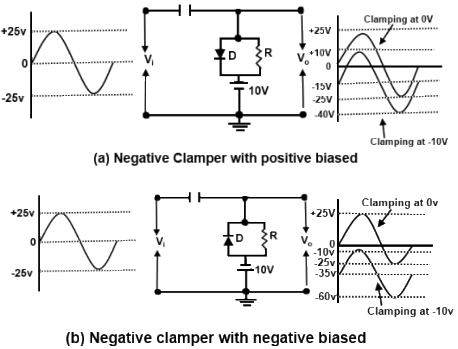
Similarly it is possible to clamp the input waveform negatively at by reversing the battery connections as shown in Fig 5(b)
ASYNCHRONOUS AND SYNCHRONOUS CLAMPING
Clamping circuit discussed above are example of clamping circuit in which the time during which the clamping is effective is controlled by the signal itself is called non synchronous or Asynchronous On the other hand, When the time of clamping is not determined directly by the signal but is determined rather by an auxiliary voltage. Such circuits are called synchronous clamping circuit. For example, suppose the wave form of Fig 6(a) is to be used to displace the beam of a cathode-ray tube linearly with time, first in one direction and then in other direction from some fixed initial point. If the signal is transmitted through - an ac coupling network whose. low -frequency time constant is not very large in comparison with the time interval T1, signal will distort as shown in Fig, 6 (b). The cause defect in the waveform is that the two displacements will start for different point A and B Also the d c level VR is lost.
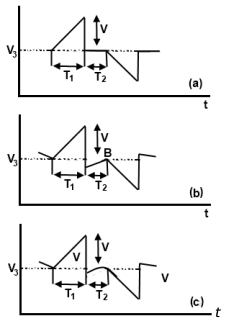
If however, the signal is passed through the circuit of Fig 7 and if switch S is closed during time interval T2 and is open during time T1, the wave form will receive as in Fig 6(c) The pips which appear when the voltage returns to the level R will be reduced to' infinitesimally narrow spikes as the resistance of the switch Rf approaches zero.
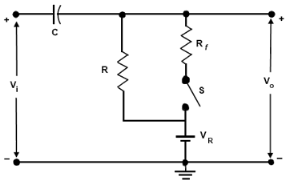
It is needed that the switch S be open throughout the time interval T1, but it is not necessary that thy switch be closed of the entire interval T2. It is only needed that the switch be closed for a period long enough to allow the capacitor C to acquire or lose enough charge to bring the output terminal to the reference level VR.
TRANSISTOR CLAMPING
Let us consider an amplifier circuit in which fixed current bias is obtained by connecting a resistor RB from the base to the supply voltage as shown in Fig 8. If the signal swing is small then base to emitter junction always conduct. The emitter base junction voltage remains forward -biased and the transistor behaves just like a small signal class-A amplifier.
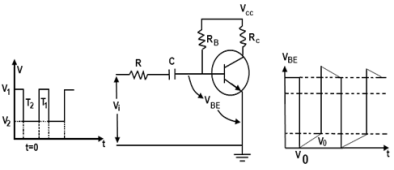
On the other hand, it a large amplitude signal is employed. Clamping will take place at the positive extremities of the wave form and transistor will operate below the cut-off during a portion of each cycle If the transistor goes in to saturation in the absence of a signal, by the combination of Vcc and RB it means that transistor is driven between cut-off and saturation by an external signal the input and output waveform arc also shown with the circuit.
USES OF CLAMPING CIRCUITS
Clamping circuit are used to shift any part of the input signal waveform and can be maintained at a specified voltage level Such circuit are used in television receivers to restore the original d.c reference signal (corresponding to the brightness level of the picture) to the video Signal The clamping of peak (i.e. 2Vm, 3Vm, 4Vm etc.,) Such to circuit are known as voltage multipliers These circuit are used to supply power to thigh voltage/low current devices like cathode ray tubes used in Television receivers, oscilloscopes and computer displays.
Voltage Multiplier
Voltage multiplier is a circuit which produces an output d.c voltage whose value is a multiple of peak a.c input voltage (i.e., 2Vm, 3Vm, 4Vm and so on). SILK circuits are used as a power supply for high voltage/low current device like cathode ray tubes.
